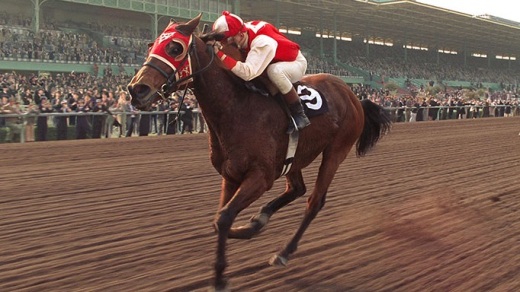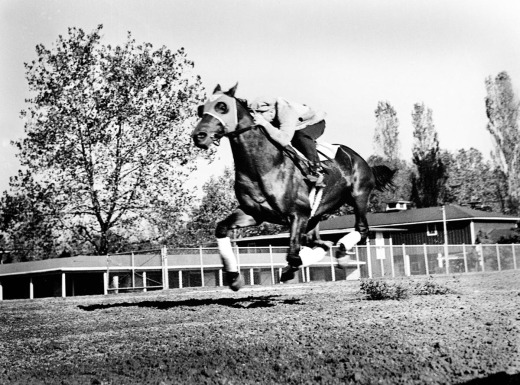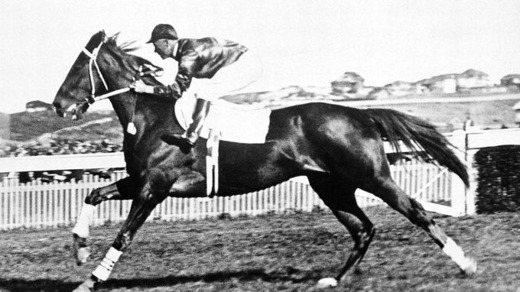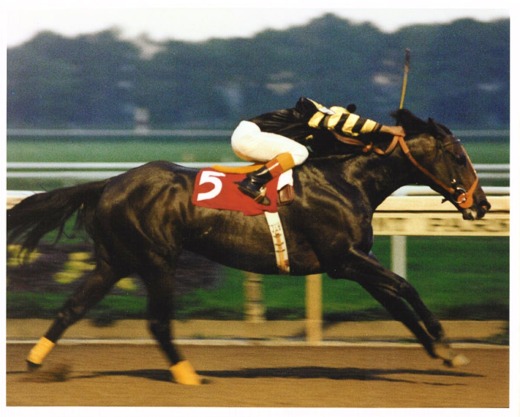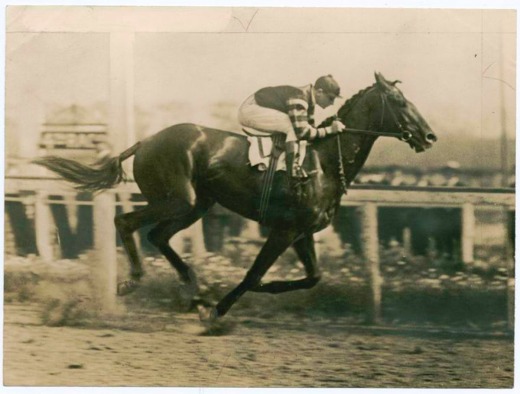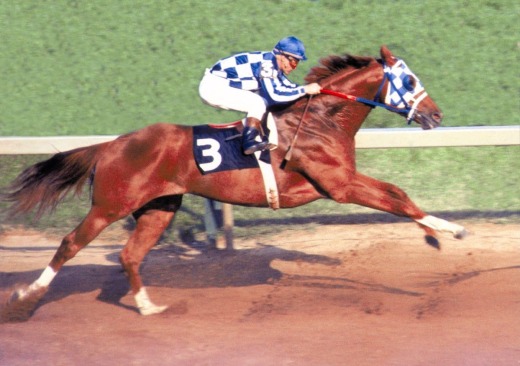Seabiscuit and the World’s Best Racehorses
The history of horse racing goes back in history all the way to Ancient Egypt, Syria, and Babylon. Chariot racing was very popular in Ancient Greece and Rome and was included in the Greek Olympics. Racing was called the “Sport of Kings”, and a good racehorse could cost a fortune. Nowadays, it remains one of the most popular types of equestrian sports. This article lists the greatest racehorses in recent Western history.
5. Seabiscuit
Foaled: 1933
Record: 89: 33-15-1
Earned: $437,730
Seabiscuit was America’s top-winning racehorse until the 1940s. He also became a subject of several literary and cinematic works. “Seabiscuit”, a 2003 film adaptation of a book by Laura Hillenbrand, was an Academy Award nominee for the Best Picture.
Seabiscuit was sired from Swing On by a son of Man O’War, Hard Track. He grew up on Claiborne Farm in Kentucky. His trainer, “Sunny Jim” Fitzsimmons, believed that the horse was too lazy and did not devote much time to him. Seabiscuit did not have a good start in racing: he only won 10 races out of his first 40. In 1936, he was sold to Charles S. Howard and assigned a new trainer, Tom Smith, which marked a radical change in his racing career.
In 1937, Seabiscuit ran in the most prestigious race in California, the Santa Anita Handicap, known as the “Hundred Grander” because of the $125,000 prize, and finished fifth. He then won five races in the period between the 26th of June and the 7th of August and then finished third in the Narragansett Special carrying the heaviest weight of his entire career, 60 kg. He managed to beat War Admiral, the winner of the Triple Crown, by four lengths and became the leading money winner of 1937. In 1938, he became the American Horse of the Year. In 1940, Seabiscuit ran the Santa Anita Handicap once again and won it by one length and a half.
During his retirement, Seabiscuit sired over a hundred foals.
4. Phar Lap
Foaled: 1926
Record: 51:37–3–2
Earned: £A66,738
Phar Lap, a Thoroughbred chestnut gelding foaled in New Zealand, was a star of Australian horse racing and the world’s 3d highest-stakes winner. The horse’s name is derived from a Thai word meaning “lightning”, and he received several nicknames such as “Red Terror”, “Wonder Horse”, and “Big Red” (a nickname also given to Secretariat).
Phar Lap was foaled in Seadown, New Zealand. His dame was Entreaty, and the sire was Night Raid who also sired Nightmarch, the winner of the Melbourne Cup. The horse was purchased by David J. Davis, an American businessman, and shipped to Australia. Upon his arrival, he appeared to be a disappointment, with his clumsy gate and warts all over his face. Davis actually refused to train the horse, so that Harry Telford, the trainer who persuaded Davis to buy the horse, agreed to train Phar Lap for free. The beginning of his racing career was unimpressive: Phar Lap came last in his very first race and did not achieve anything noteworthy in the following three races either.
His first victory came on the 27th of April 1929, and from then onwards his results began to improve. In September of the same year, he won the Rosehill Guineas by three lengths. In total, he won 37 races of the 51 races he participated in during his 4-year racing career. His victories include the Melbourne Cup, the AJC Derby, and 2 Cox Plates. He was even shipped to Tijuana, Mexico, to participate in a race at the Agua Caliente racetrack, which he won in track-record time.
Phar Lap died in 1932 of a mysterious illness which led many to suggest that he had been poisoned.
3. Seattle Slew
Foaled: 1974
Record: 17: 14–2–0
Earned: $1,208,726
Seattle Slew was the 10th of the 13 horses that have ever won the Triple Crown. He was named the Horse of the Year in 1977 and ranked 9th in the List of Top U.S. Racehorses of the 20th Century. The horse was extremely popular and a favorite every time he ran. As Joe Hirsch wrote, “The response to his presence on the racetrack, either for a morning workout or a major race, was electric. ‘Slewmania’ was a virulent and widespread condition.”
Seattle Slew was foaled at the White Horse Acres, his breeder being Ben S. Castleman. His Dame, My Charmer, later produced Lomond, the winner of the 2000 Guineas Stakes. The sire was Bold Reasoning, the 1971 winner of the Jersey Derby. The future champion was an awkward foal and was said to look rather like a mule. His unimpressive looks earned him a nickname “Baby Huey”. However, as the horse grew, he acquired both strength and grace, so that his running style was compared to a “falcon in a dive”. His trainer, Billy Turner, said that Seattle Slew had an intelligent and dominant personality: “He liked people, but he wasn’t lovey-dovey. He didn’t like people petting him. He would stand back and just look at you. He would let you do whatever you wanted him to do, but only if he wanted to do it.”
In 1976, having started only 3 times, Seattle Slew became the Champion Two-Year-Old. In 1977, he won the Triple Crown of Thoroughbred Racing. He is one of only ten in history to win this title with an undefeated record.
In 1984, Seattle Slew was the leading sire in North America. Swale and A.P. Indy, sired by him, both won the Belmont Stakes.
2. Man O’War
Foaled: 1917
Record: 21: 20–1–0
Earned: $249,465
Man O’War, a chestnut American Thoroughbred, is one of the greatest racehorses there ever was. He won every race he participated in except for one and his achievements were honored by the National Museum of Racing and Hall of Fame.
Man O’War was bred by August Belmont, Jr., the chairman of the Jockey Club and a renowned breeder. The famous Belmont Stakes race was named after August’s father. Man O’War’s sire, Fair Play, finished second at the 1908 Belmont Stakes, and his dame, Mahubah, was sired by Rock Sand, the champion of the English Triple Crown. The colt got his name in honor of his breeder who joined the US army during World War I the same year Man O’War was foaled. He had a violent temper, would dump his riders and “fought like a tiger”. However, Frank Loftus, the groom, eventually trained the horse to fetch his hat.
From the very beginning of his racing career, Man O’War had been a favorite. He won the 1920 Lawrence Realization Stakes by a hundred lengths and set records in numerous races. Man O’War won all the major races of his time, including the Hopeful Stakes at Saratoga Springs and the Belmont Futurity Stakes. However, he never entered the Kentucky Derby because Samuel Riddle, his owner, decided against it.
When Man O’War retired, he was the leading money-earner in the history of American racing. He had sired War Admiral, the winner of the Triple Crown, as well as many other champions, and his line still continues today.
1. Secretariat
Foaled: 1970
Record: 21:16–3–1
Earned: $1,316,808
Secretariat, nicknamed “The Big Red” for his bright red color, is America’s most famous racehorse. His racing career was a short one, but his phenomenal record for 1 1⁄2 miles on dirt still stands.
Secretariat Was bred at the Meadow Stud owned by Christopher Chenery, and, later, Penny Chenery. His sire, Bold Ruler, had been North America’s leading sire and the dame, Somethingroyal, had been sired by Princequillo, a known long-distance race champion. The foal stood out among the others from a very early age. As Robert, the nephew of Meadow Stud manager Howard Gentry said, “He had a personality. He was a clown and was always cutting up, always into some devilment.” He grew up to be a strong, massive horse with a large stride, standing 168cm tall, with an exceptionally large chest, so that the girth for him had to be custom made. Seth Hancock described him as “the greatest athlete in the world” and “the best-looking guy ever to come down the pike”.
His racing career, however, did not start well. He was strong but clumsy, and Charlie Davis, one of his two exercise riders, called him “a big fat sucker” who “wasn’t in a hurry to do nothing.” In his first race at Aqueduct Racetrack in 1972, he came fourth. After that, Secretariat started winning. He won the rest of the races that year, except for one, got the Eclipse Award as a champion two-year-old colt, and was also named 1972 Horse of the Year.
1973 was Secretariat’s record year. He became the first horse to win the Triple Crown in 25 years, and the ninth in history. He achieved his greatest victory on June 9, at the Belmont Stakes. He was already considered a favorite, his main competitor being Sham, a Claiborne Farm horse and one of the best-known horses of the XXth century. Secretariat won the race by the incredible 31 leads. When he began steadily increasing the distance between himself and the rest of the horses, the commentator Chic Anderson exclaimed: “Secretariat is widening now! He is moving like a tremendous machine!” Secretariat’s time of the race, 2:24 flat, was the fastest 1 1⁄2 miles on dirt in history, and this record has not yet been beaten.
After Secretariat’s death, it was discovered that his heart was twice as large as a normal horse’s heart.
Words: Jelena Schmidt

